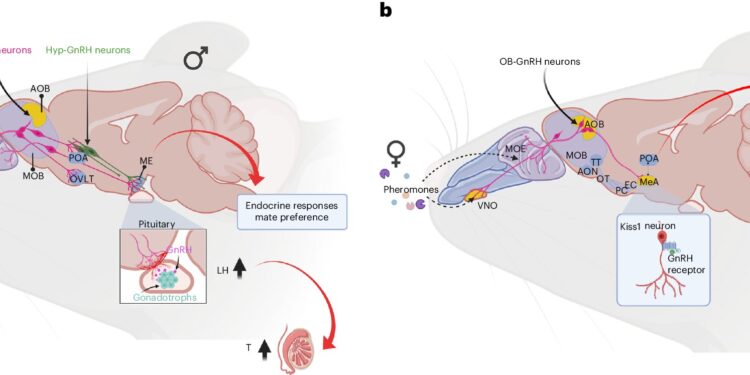GnRHCROWD and GnRHAOB Neural projections and neuroendocrine/behavioral responses to odors in male mice. Credit: Neuroscience of Nature (2024). DOI: 10.1038/s41593-024-01724-1
Animal reproduction relies on the integration of various external and internal processes. These processes include a combination of perceived sensory signals, behaviors, and hormonal secretions.
In many animal species, reproduction relies on the detection of sex-specific hormones called pheromones. These hormones are picked up by a part of the olfactory system called the vomeronasal system.
One type of neuron known to play a key role in mammalian reproduction is the so-called gonadotropin-releasing hormone (GnRH) neurons. These neurons, which are located primarily in the hypothalamus, regulate the reproductive system by controlling the release of gonadotropins from the pituitary gland (a pea-sized region of the brain responsible for hormone secretion).
Gonadotropins are hormones essential for the development of male and female reproductive organs, including the ovaries and testes. These hormones are known to be central regulators of reproductive health, as they support processes such as ovulation, sperm production, and sexual development.
Researchers from Labex DistAlz at the Faculty of Medicine in Lille, France, and other institutes in Europe recently conducted a study in mice to better understand how GnRH neurons contribute to reproduction. Their results, published in Neuroscience of Naturesuggest that GnRH neurons in the olfactory bulb of adult male mice translate socially relevant odors into reproductive behaviors.
“We show that GnRH neurons in the olfactory bulb (GnRHOB) adult mice can mediate social recognition,” Laurine Decoster, Sara Trova and their colleagues wrote in their paper.
“More specifically, we show that GnRHOB Neurons extend neurites into the vomeronasal organ and olfactory epithelium and project to the median eminence.OB “Male neurons express vomeronasal and olfactory receptors, are activated by female odors, and mediate gonadotropin release in response to female urine.”
Distribution of GnRH neurons in the olfactory bulbs of humans. Credit: Neuroscience of Nature (2024). DOI: 10.1038/s41593-024-01724-1
The research team conducted a series of experiments on adult mice. Using various genetic techniques, the researchers closely observed the anatomy and connectivity of GnRH neurons in the mice’s olfactory bulb, a structure located in the frontal part of the brain responsible for processing odors and olfactory information.
The data collected by the researchers suggest that this population of GnRH neurons located outside the hypothalamus is responsible for integrating chemosensory signals with information about sexual attraction behavior and corresponding hormonal changes in male mice. In males, these neurons primarily capture olfactory and hormonal signals, translating them into sexual arousal and reproductive behavior.
“Male preference for feminine odors required the presence and activation of GnRHOB “Neuron function was impaired after genetic inhibition or ablation of these cells and was dependent on GnRH signaling in the posterior-dorsal medial amygdala,” the researchers wrote.
“GnRH receptor expression in amygdala kisspeptin neurons appears to be required for GnRHOB Actions of neurons on male mounting behavior.
Overall, the results collected by Decoster, Trova and colleagues suggest that GnRH neurons in the mouse olfactory bulb play a crucial role in regulating male fertility, recognition of female mice and mating.
In the future, this recent work could inspire further research focused on this neuronal population, including studies to determine whether they play a similar role in humans.
More information:
Laurine Decoster et al, A GnRH neuronal population in the olfactory bulb translates socially relevant odors into reproductive behavior in male mice, Neuroscience of Nature (2024). DOI: 10.1038/s41593-024-01724-1
© 2024 Science X Network
Quote:GnRH neurons in the mouse olfactory bulb were shown to be able to translate socially relevant odors into male reproductive behavior (2024, August 23) retrieved August 23, 2024 from
This document is subject to copyright. Apart from any fair dealing for the purpose of private study or research, no part may be reproduced without written permission. The content is provided for informational purposes only.



